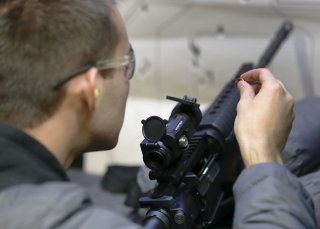Meet Armalite–the Company Behind the AR-15
Here's what you need to know.
A common misconception today—especially among those who don’t really know, or worse simply dislike firearms—is that the “AR” in AR-15 is for “assault rifle,” but in fact AR is for ArmaLite, the American small arms engineering company that was founded in 1954 in Hollywood, California.
It actually grew out of the Fairchild Engine and Airplane Corporation and while it would go on to produce the now famous/infamous AR-15—its very first firearm was also a sign of the things to come.
That was the AR1 Parasniper, an experimental rifle that utilized a foam-filled fiberglass stock and alloy barrel. While largely forgotten, the bolt-action rifle was unique and innovative. It was tested at the Aberdeen Proving Ground in 1955 and while it wasn’t adopted, it certainly paved the way for the company’s AR-7 aircrew survival weapon.
That semi-automatic firearm, which was chambered for .22 long rifle, was adopted by the military and later marketed for outdoor use as a weapon for foraging or defense out in the wilds. Today it is still produced as the Henry AR-7 and, just like the version designed for Air Force pilots, can be assembled and disassembled within one minute. It is lightweight yet accurate and is the weapon anyone stranded in the woods would be happy to have at their side.
The AR-7 was also notable in that it was designed by Eugene Stoner—the man who would go on to develop the AR-10 and then the AR-15. As The National Interest previously reported, the AR-10 was radical in concept. For instance, it used an in-line design where the barrel, bolt and stock were all aligned in a single axis for maximum controllability.
As with other ArmaLite small arms the AR-10 used advanced materials including aluminum and fiberglass to reduce weight. The gas system was also different than the external piston systems employed in the FAL FN or other firearms of the era. Instead the gas was vented through the gas tube directly into a piston formed by the bolt and a chamber in the bolt carrier. That eliminated the need for an external pistol and reduced the recoiling mass significantly.
However, the Army wasn’t impressed—in part because the concept was simply too radical at the time. The Army played it safe and instead went with the M-14, which was in essence a worthy evolution of the M1 Garand.
But Stoner pressed on, went back to the drawing board and refined his concept as the AR-15. Yet, rather than take another risk, Fairchild licensed the design for the AR-10 and AR-15 to Colt. Fairchild then sold its interest in ArmaLite in 1962, the same year Colt sold the AR-15 to the United States Air Force.
The U.S. Army adopted the AR-15 two years later as the “Rifle, Caliber 5.56mm, M16” and the rest as they say is history. ArmaLite had limited success in the subsequent years, only to cease operations in the early 1980s. The company was re-launched in 1996 by Mark Westrom and now produces a range of products including the AR-10 and the M-15 tactical carbine.
Peter Suciu is a Michigan-based writer who has contributed to more than four dozen magazines, newspapers and websites. He is the author of several books on military headgear including A Gallery of Military Headdress, which is available on Amazon.com.
Image: Reuters

